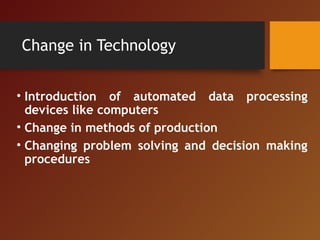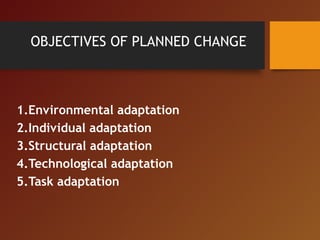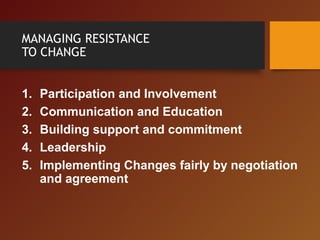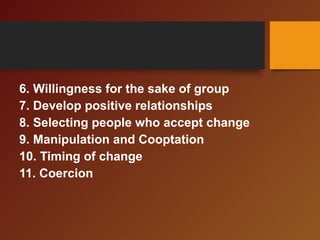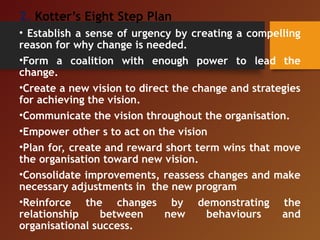Change management
- 2. CHANGECHANGE Means the alteration of status quo Is the necessary aspect of human life One of the few things of real permanence is ‘change’. Whole society is changing in some form or other
- 3. ORGANIZATIONAL CHANGE • Refers to alteration of work environment in an organization. Eg:- Technology, Structural arrangement, Job design, people etc • Change in any part of the organisation affects the entire organisation and some subsequent changes are required in other parts • OC is required to maintain equilibrium between various external and internal forces to achieve organizational goals
- 4. External factors Technological changes Changes in marketing conditions Economic shocks Social changes Political and legal changes Internal Factors Nature of workforce Change in managerial personnel Deficiency in existing organisation Change in share holders / BOD Forces for Organizational change
- 5. CHANGE PROCESSCHANGE PROCESS (Actions for Change)(Actions for Change) 1. Unfreezing the situation 2. Changing 3. Refreezing
- 6. UNFREEZING Process makes individual or organization aware and prepares them for change (Change should not be surprise)
- 7. CHANGING • Moving to the new condition • Individuals are changed to learn new behaviour • For effective changing • Recognise that primary purpose of change is to improve performance • Make individuals responsible for their own change • Encourage team performance • Encourage learning by doing
- 8. STEPS IN MANAGING CHANGE 1. Identify the need for change and area of change 2. Develop new goals and objectives 3. Select an agent for change 4. Diagnose the problem
- 9. 5. Select methodology 6. Develop a plan 7. Strategy for implementation of the plan 8. Implementation of the plan 9. Receive and evaluate feedback
- 10. PLANNED CHANGE • Planned change aims to prepare total organisation or a major portion of it to adapt to significant changes in the organization's goals and directions. • It attempts all aspects of organization which are closely interrelated - technology, task, structure and people.
- 12. • Introduction of automated data processing devices like computers • Change in methods of production • Changing problem solving and decision making procedures Change in Technology
- 13. • Technology changes affect nature of task. It determines type of task that may be required to complete an operation. • Task related changes must focus on. 1. High internal work motivation 2. High quality work performance TASK RELATED CHANGES
- 14. STRUCTURE RELATED CHANGES 1. Changing no of hierarchical levels 2. Changing one form of organization to another form 3. Changing span of management 4. Changing authority PEOPLE RELATED CHANGES 1. Skills 2. Behaviour
- 15. OBJECTIVES OF PLANNED CHANGE 1.Environmental adaptation 2.Individual adaptation 3.Structural adaptation 4.Technological adaptation 5.Task adaptation
- 16. RESISTANCE TO CHANGE • Change, no matter how beneficial, is generally resented and is always difficult to implement. There are many factors that increase resistance to change.
- 17. FACTORS 1. Insecurity 2. Lack of communication 3. Rapidity and extend of change 4. Group resistance 5. Emotional turmoil 6. Loss of power and control 7. Reduced opportunity for incentives 8. Status quo 9. Lack of trust in change agent 10. Sunk cost
- 18. MANAGING RESISTANCE TO CHANGE 1. Participation and Involvement 2. Communication and Education 3. Building support and commitment 4. Leadership 5. Implementing Changes fairly by negotiation and agreement
- 19. 6. Willingness for the sake of group 7. Develop positive relationships 8. Selecting people who accept change 9. Manipulation and Cooptation 10. Timing of change 11. Coercion
- 20. Approaches to Manage Organisational Change 1. Lewin’s Three Step Model REFREEZING MOVEMENT UNFREEZING
- 21. 2. Kotter’s Eight Step Plan • Establish a sense of urgency by creating a compelling reason for why change is needed. •Form a coalition with enough power to lead the change. •Create a new vision to direct the change and strategies for achieving the vision. •Communicate the vision throughout the organisation. •Empower other s to act on the vision •Plan for, create and reward short term wins that move the organisation toward new vision. •Consolidate improvements, reassess changes and make necessary adjustments in the new program •Reinforce the changes by demonstrating the relationship between new behaviours and organisational success.
- 22. 3. Action Research - Change based on systematic collection of data and selection of change action based on what the analysed data indicate. 4. Organizational Development – collection of change methods that try to improve organizational effectiveness and employee wel being











